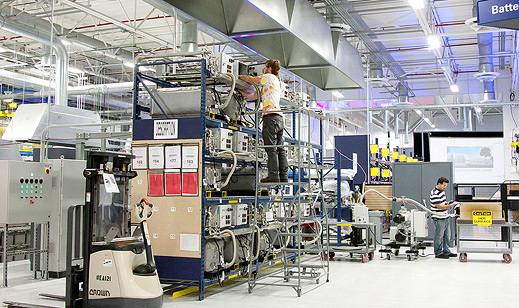Building an Industrial Internet

The Big Brother of manufacturing is around the corner - you can see for yourself at General Electric's $170 million plant that opened less than a year ago in Schenectady, New York. Soon, this factory aims to keep its eyes on each individual product made, as well as each factory condition that existed during its creation.
The 180,000 square-foot sodium-nickel battery factory looks to accomplish this using more than 10,000 sensors connected through high-speed internal Ethernet stationed throughout the facility. Details such as air pressure, temperature, and even which batch of powder was used to create the ceramics of a particular battery are recorded.
And while industrial networking and big data for manufacturing aren't new, Jeff Inmelt, GE's CEO, believes the industry is on the verge of a revolution that will increase worker productivity and factory efficiency.
To back up this claim, the company is investing $1.5 billion over a three year period, much of which will be concentrated in the Schenectady plant. Bar codes and serial numbers are attached to every component of every battery that the factory produces. Employees can access this data from their iPads via Wi-Fi nodes around the factory. Managers can compare energy expenditure on one battery compared to the average; they can also perform ad hoc analyses on their workstations.
This sensor data has already produced significant insights, according to Randy T. Rausch, business analytics and manufacturing information leader at GE Energy Storage. For example, GE found that batteries that spent more than a certain time in factory ovens were more likely to fail quality tests. They have mitigated this risk by installing alarms that flash near parts that are approaching their limit.
But other manufacturers aren't convinced that GE's industrial Internet is a new idea, since many companies have been using big data analytics for years. To address this, MIT Technology Review's Michael Fitzgerald claims that GE will need to prove what a bigger network pulling in more data can do that existing systems can't.
And what about the industrial Internet revolution? Well, at the moment it's more of an intranet, says Rausch. Short term plans to integrate the outside world involve accessing weather forecasts in order to changes factory conditions in order to adjust to outside changes in temperature and humidity. But eventually, he continues, embedded chips will enable GE to track the performance of its batteries after they leave the factory.
According to Rausch, within a few years GE will be able to draw connections between the performance of one customer's dishwasher or refrigerator with the exact conditions under which each component was made, making the Internet connections between the factory floor and the outside world the most valuable of all.
Full story at MIT Technology Review










